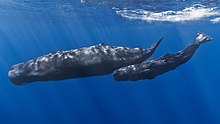எண்ணெய்த் திமிங்கிலம்
| Sperm whale[1] | |
|---|---|

| |

| |
| உயிரியல் வகைப்பாடு | |
| Unrecognized taxon (fix): | Physeterinae |
| பேரினம்: | |
| இனம்: | P. macrocephalus
|
| இருசொற் பெயரீடு | |
| Physeter macrocephalus லின்., 1758 | |

| |
| எண்ணெய்த் திமிங்கிலங்கள் மிகுதியாகக் காணப்படும் இடங்கள் | |
| வேறு பெயர்கள் | |
|
Physeter catodon, காற்றுப்புரையுடையி பெருந்தலை லின்., 1758 Physeter australasianus Desmoulins, 1822 | |
எண்ணெய்த் திமிங்கிலம் (sperm whale, Physeter macrocephalus அல்லது cachalot) பல்லுள்ள திமிங்கிலங்களிலும் பல்லுடைய கோண்மாக்களிலும் ஆகப்பெரிய விலங்காகும். பைசெட்டர் (Physeter) எனும் காற்றுப்புரையுடையி பேரினத்தின் இன்று வாழும் ஒரே இனம் இதுதான். எண்ணெய்த் திமிங்கிலம் சார்ந்த விலங்குக் குடும்பத்தின் மூன்று உறுப்பினர்களில் இதுவும் ஒன்று ஆகும்.
எண்ணெய்த் திமிங்கிலங்கள் உலகெங்கிலும் காணக்கூடிய மிதவைப் பாலூட்டிகள் ஆவன. இவை இரைதேடியும், இனப்பெருக்கத்துக்காகவும் காலநிலைக்கேற்ப வலசை செல்பவை.[3] பெண் திமிங்கிலங்களும் இளம் ஆண் திமிங்கிலங்களும் கூட்டமாக வாழும். வயதுவந்த ஆண் திமிங்கிலங்கள் பெரும்பாலும் தனித்து வாழும். இனப்பெருக்க காலங்களில் மட்டுமே பிற திமிங்கிலங்களை நாடும். பெண் திமிங்கிலங்கள் தமக்கிடையே ஒத்துழைத்து கூட்டாகக் கன்றுகளுக்குப் பாலூட்டவும் அவற்றைப் பாதுகாக்கவும் செய்கின்றன. நான்கு முதல் இருபது ஆண்டுகள் வரையிலான இடைவெளியில் பெண் திமிங்கிலங்கள் கன்றுகளை ஈனுகின்றன. பத்து ஆண்டுகள்வரை தமது கன்றுகளை வளர்க்கின்றன. நன்கு வளர்ந்த எண்ணெய்த் தமிங்கிலங்களைத் தாக்கி வேட்டையாடக்கூடிய கோண்மாக்கள் அரிது. கன்றுகளையும் வலுவிழந்த பெரிய எண்ணெய்த் திமிங்கிலங்களையும் கொல்லும் திமிங்கிலங்கள் என்றழைக்கப்படும் ஓர்க்காக்கள் கூட்டமாகவந்து வேட்டையாடும்.
வளர்ந்த ஆண் திமிங்கிலங்கள் சராசரியாக 16 மீட்டர்கள் (52 அடி) நீளம் கொண்டவை, னால் சிலவேளைகளில் 20.5 மீட்டர்கள் (67 அடி) வரை வளர்கின்றன. இவ்விலங்கின் நீளத்தில் தலை மட்டுமே மூன்றில் ஒரு பங்கு வரை இருக்கக் கூடும். 2,250 மீட்டர்கள் (7,382 அடி) வரை செல்லக்கூடிய இவை, கவியரின் அலகொத்தவாய்த் திமிங்கிலங்களுக்கு அடுத்தபடியாக இரண்டாவதாகக் அதிக ஆழம் வரை செல்லும் பாலூட்டிகள்.[4] பெரிய பெட்டி வடிவத் தலையையும், சிறிய கீழ்த்தாடையையும் சிறு கண்களையும் உடைய இவை பெரிய திமிங்கில வகைகளுக்குள் எளிதில் அடையாளம் காணத் தக்கவை.[5]
எண்ணெய்த் திமிங்கிலங்கள் எதிரொலிமுறைத் தூரமறிதல் துணையுடன் இரையையும் பிறவற்றையும் கணிக்கின்றன. 230 தெசிபெல் வரை சத்தமாக ஒலி எழுப்புகின்றன.[6] உலகில் வாழும் விலங்குகளிலேயே மிகப்பெரிய மூளை இவற்றுக்குத்தான் உண்டு. மனித மூளையைப் போல 5 மடங்கு எடை கொண்டவை இவற்றின் மூளைகள். இவை 60 வயதுக்கும் மேல் வாழக்கூடியவை.[7]

இவற்றின் தலையிலுள்ள எண்ணெயினாலேயே இவை இப்பெயர் பெற்றுள்ளன. ஆங்கிலத்தில் sperm whale என்று அழைப்பதும் இவற்றின் எண்ணெய்க் கொழுப்பை விந்துப் பாய்மம் எனப்பிழையாகப் புரிந்துகொண்டதாலேயே. இந்த எண்ணெயை விளக்கில் எரிபொருளாகப் பயன்படுத்தவும், மசகெண்ணெயாகப் பயன்படுத்தவும், மெழுகிற்காகவும் இவை வேட்டையாடப்பட்டன. இன்றும் இவற்றின் வயிற்றில் காணப்படும் பிசுபிசுப்பானவொரு கழிவுப்பொருளை நறுமணப்பொருள்களில் ஒட்டுமைக்காகப் பயன்படுத்துகிறார்கள். அதனை திமிங்கில வாந்தி என்று அழைக்கின்றனர். இவற்றைப் பெறுவதற்காக கடற்கரைகளில் மிதந்து ஒதுங்கும் கழிவுகளில் மக்கள் தேடுகிறார்கள்.[8] இவை பன்னாட்டு இயற்கைப் பாதுகாப்புச் சங்கத்தால் அழிவாய்ப்புள்ள இனமாக அறிவிக்கப்பட்டுள்ளபடியால் இவற்றை வேட்டையாடுவதிலிருந்து திமிங்கில வேட்டைக் குழுமத்தினர் தாமாக விலகியிருக்கின்றனர்.
இந்தியாவின் கடற்கரையோரங்கள் முழுவதும் இவற்றின் வாழிடங்களாக இருக்க வாய்ப்புள்ளதெனினும் குசராத்து, கருநாடகம், மகாராட்டிரம், கேரளம், தமிழ் நாடு, புதுவை, அந்தமான் நிக்கோபர், இலட்சத்தீவு கடற்கரைகளில் இவை பதிவாகியுள்ளன.[5] இலங்கையில் கற்பிட்டி, திருகோணமலை, மிரிச, தேவேந்திரமுனை ஆகிய பகுதிகளில் இவற்றைக் காணலாம்.
இதனையும் காண்க
[தொகு]குறிப்புகளும் மேற்கோள்களும்
[தொகு]- ↑ Mead, J.G.; Brownell, R. L. Jr. (2005). "Order Cetacea". In Wilson, D.E.; Reeder, D.M (eds.). Mammal Species of the World: A Taxonomic and Geographic Reference (3rd ed.). Johns Hopkins University Press. p. 737. பன்னாட்டுத் தரப்புத்தக எண் 978-0-8018-8221-0. இணையக் கணினி நூலக மைய எண் 62265494.
{{cite book}}: Invalid|ref=harv(help) - ↑ Taylor, B.L.; Baird, R.; Barlow, J.; Dawson, S.M.; Ford, J.; Mead, J.G.; Notarbartolo di Sciara, G.; Wade, P. et al. (2008). "Physeter macrocephalus". செம்பட்டியல் (பன்னாட்டு இயற்கைப் பாதுகாப்புச் சங்கம்) 2008: e.T41755A10554884. doi:10.2305/IUCN.UK.2008.RLTS.T41755A10554884.en. http://www.iucnredlist.org/details/41755/0. பார்த்த நாள்: 12-01-2018.
- ↑ "SPERM WHALE". acsonline.org. Archived from the original on 2017-04-22. பார்க்கப்பட்ட நாள் 13-05-2017.
{{cite web}}: Check date values in:|accessdate=(help) - ↑ Lee, Jane J. (2014-03-26). "Elusive Whales Set New Record for Depth and Length of Dives Among Mammals". National Geographic. Archived from the original on 2014-03-29.
{{cite web}}: Italic or bold markup not allowed in:|publisher=(help) - ↑ 5.0 5.1 மேனன், விவேக் (2014). இந்தியப் பாலூட்டிகள் (in ஆங்கிலம்). குருகிராமம்: ஆச்செட்டு. p. 478. பன்னாட்டுத் தரப்புத்தக எண் 9789350097601.
- ↑ Trivedi, Bijal P. (3 November 2003). "Sperm Whale "Voices" Used to Gauge Whales' Sizes". news.nationalgeographic.com.
- ↑ Degrati, M.; García, NA; Grandi, MF; Leonardi, MS; de Castro, R; Vales, D.; Dans, S.; Pedraza, SN et al. (2011). "The oldest sperm whale (Physeter macrocephalus): new record with notes on age, diet and parasites, and a review of strandings along the continental Argentine coast". Mastozoología Neotropical 18 (2). http://www.scielo.org.ar/scielo.php?script=sci_arttext&pid=S0327-93832011000200013&lng=en&nrm=iso&tlng=en.
- ↑ Spitznagel, Eric (12 January 2012). "Ambergris, Treasure of the Deep". bloomberg.com. https://www.bloomberg.com/news/articles/2012-01-12/ambergris-treasure-of-the-deep. பார்த்த நாள்: 25 May 2017.
வெளி இணைப்புகள்
[தொகு]
- The Dominica Sperm Whale Project- a long-term scientific research program focusing on the behaviour of sperm whale units.
- Spermaceti in candles பரணிடப்பட்டது 2005-12-31 at the வந்தவழி இயந்திரம் 22 July 2007
- Society for Marine Mammalogy Sperm Whale Fact Sheet
- US National Marine Fisheries Service Sperm Whale web page
- 70South—information on the sperm whale
- "Physty"-stranded sperm whale nursed back to health and released in 1981
- ARKive பரணிடப்பட்டது 2005-04-04 at the வந்தவழி இயந்திரம்—Photographs, video.
- Whale Trackers—An online documentary film exploring the sperm whales in the Mediterranean Sea.
- Convention on Migratory Species page on the Sperm Whale
- Website of the Memorandum of Understanding for the Conservation of Cetaceans and Their Habitats in the Pacific Islands Region
- Official website of the Agreement on the Conservation of Cetaceans in the Black Sea, Mediterranean Sea and Contiguous Atlantic Area
- Retroposon analysis of major cetacean lineages: The monophyly of toothed whales and the paraphyly of river dolphins 19 June 2001
- Voices in the Sea – Sounds of the Sperm Whale பரணிடப்பட்டது 2014-12-16 at the வந்தவழி இயந்திரம்


